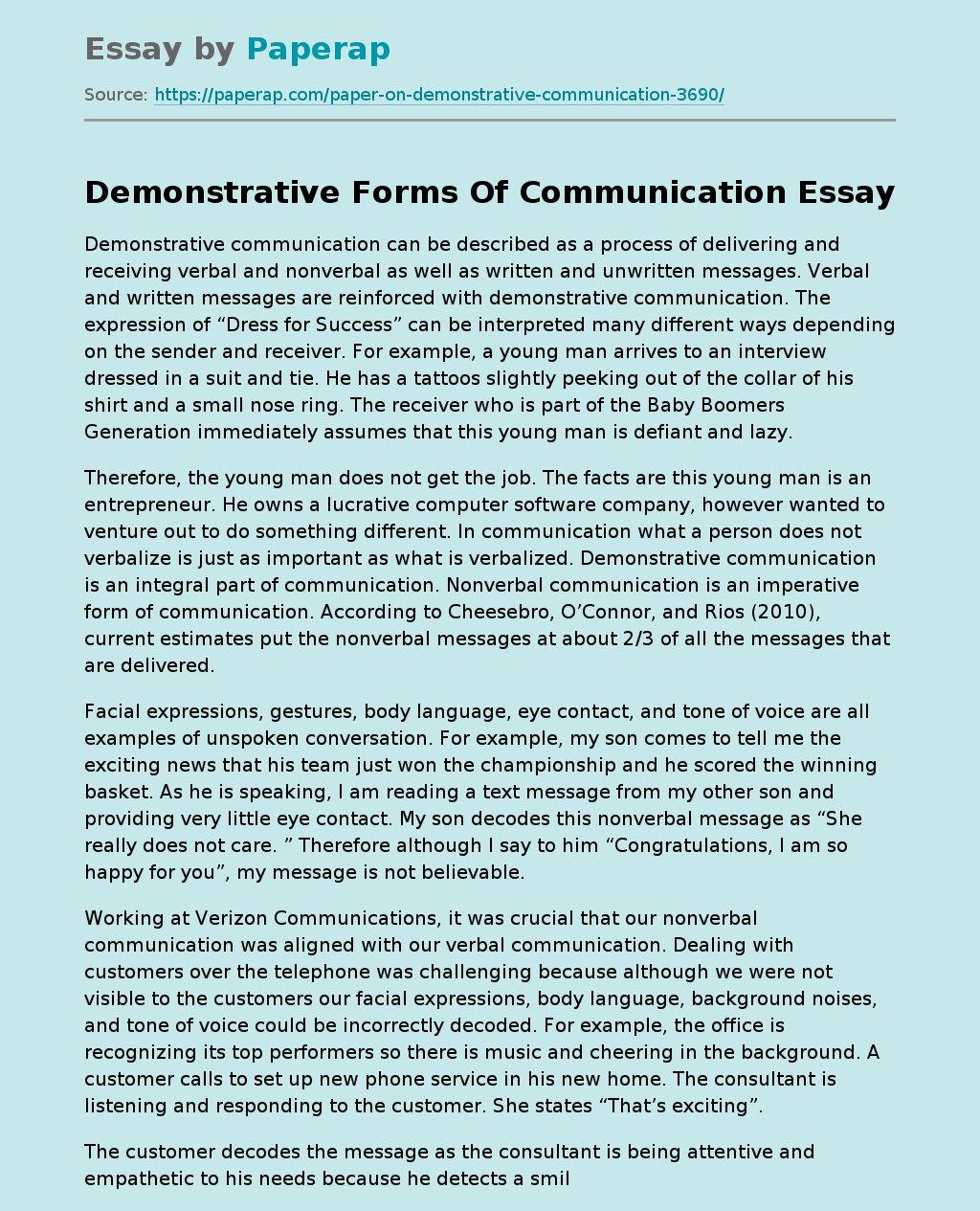Demonstrative Forms Of Communication
Demonstrative communication can be described as a process of delivering and receiving verbal and nonverbal as well as written and unwritten messages. Verbal and written messages are reinforced with demonstrative communication. The expression of “Dress for Success” can be interpreted many different ways depending on the sender and receiver. For example, a young man arrives to an interview dressed in a suit and tie. He has a tattoos slightly peeking out of the collar of his shirt and a small nose ring.
The receiver who is part of the Baby Boomers Generation immediately assumes that this young man is defiant and lazy.
Therefore, the young man does not get the job. The facts are this young man is an entrepreneur. He owns a lucrative computer software company, however wanted to venture out to do something different. In communication what a person does not verbalize is just as important as what is verbalized. Demonstrative communication is an integral part of communication. Nonverbal communication is an imperative form of communication.
According to Cheesebro, O’Connor, and Rios (2010), current estimates put the nonverbal messages at about 2/3 of all the messages that are delivered.
Facial expressions, gestures, body language, eye contact, and tone of voice are all examples of unspoken conversation. For example, my son comes to tell me the exciting news that his team just won the championship and he scored the winning basket. As he is speaking, I am reading a text message from my other son and providing very little eye contact.
My son decodes this nonverbal message as “She really does not care. ” Therefore although I say to him “Congratulations, I am so happy for you”, my message is not believable.
Working at Verizon Communications, it was crucial that our nonverbal communication was aligned with our verbal communication. Dealing with customers over the telephone was challenging because although we were not visible to the customers our facial expressions, body language, background noises, and tone of voice could be incorrectly decoded. For example, the office is recognizing its top performers so there is music and cheering in the background. A customer calls to set up new phone service in his new home. The consultant is listening and responding to the customer. She states “That’s exciting”.
The customer decodes the message as the consultant is being attentive and empathetic to his needs because he detects a smile in her voice. The customer does not know about the activities going on in the office. Although this type of communication can be positive, it can also have negative implications as well. The way we look, listen and interact tells the sender of the message whether or not the receiver is truly listening and engaged. These nonverbal behaviors can either enhance or diminish relationships. The sender and the receiver can effectively utilize unspoken gestures to impact their messages.
Although this is not the message intended, the encoding of this message by the sender was ineffective. All caps used in an email represent shouting. Kim simply did not realize the caps lock was on and did not review the message before sending because she was interrupted by another employee. Listening and responding is vital to ensure that the messages intended are the messages sent (Akerman, 2010) Communication is a two-way conversation. We must enable a channel for feedback whether that is by questioning, paraphrasing, or probing. Misunderstandings occur when effective listening and responding are not utilized.
In conclusion, demonstrative communication can have a positive or negative impact on messages for the sender and receiver. Understanding this concept will equip the speaker and listener with the tools necessary to influence the message intended. The outcome of the conversations at home and work can be improved with the implementation of this knowledge. The verbal and nonverbal as well as the written and unwritten communication must align in order to send a clear message. All types of communication include a sender, a receiver, a message, and a delivery channel.
Demonstrative Forms Of Communication. (2019, Dec 05). Retrieved from https://paperap.com/paper-on-demonstrative-communication-3690/

